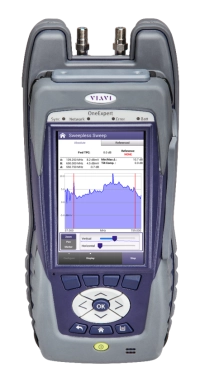Deploying and Maintaining The Advanced HFC Upstream
Broadband service providers are scrambling to keep up with unprecedented upstream bandwidth demand growth driven by rapid adoption of videoconferencing and other upstream-heavy applications. Operators have three primary options that can be mixed and matched to add capacity, but with each comes unique operationalization challenges. Only VIAVI has the complete portfolio of test solutions and the experience to help ease your transition to the advanced upstream that can help you keep up with market demands today and well into the future.
The Options, Their Pros/Cons, Popular Combinations
There have always been three primary options for gaining upstream capacity, but how we achieve them in todays networks is changing
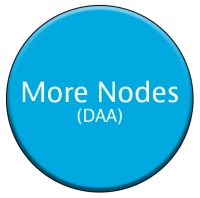
Node splits have been the go-to method for achieving greater network capacity, but rapidly filling hubs are making DAA a prerequisite to their continued use
- Pros: Transparent for outside plant - only requires touching (sometimes just virtually) ends of network (CCAP/CPE), Can be much quicker to implement vs other two options, enables some use of otherwise wasted junk band
- Cons: Impact scales proportional to D3.1 CPE coverage and plant fidelity (SNR still matters!), unlikely to be permanent solution by itself as max benefit capped
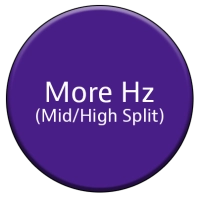
We used to add carriers to better utilize available upstream spectrum. Now that all usable spectrum is full, we must move to mid split or high split to add more carriers
- Pros: Increase US capacity up to 500% using mature technology, can have lower TCO vs continued node splits
- Cons: Requires touching every active and many passives in the plant, FCC leakage still an unknown, high split requires OFDMA to benefit, high split may drive need for DS extension
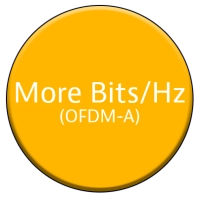
Converting upstream carriers from 16 to 64QAM used to the easy and free way to get more capacity from existing spectrum, but now that most of the world is already at 64QAM switching to OFDMA is the only option to get more bits/Hz.
- Pros: Transparent for outside plant - only requires touching (sometimes just virtually) ends of network (CCAP/CPE), Can be much quicker to implement vs other two options, enables some use of otherwise wasted junk band
- Cons: Benefit scales proportional to D3.1 CPE coverage and plant fidelity (SNR still matters!), unlikely to be permanent solution by itself as max benefit capped
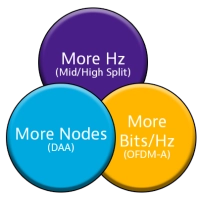
- High-Split + OFDMA - OFDMA is the only carrier type specified for use beyond 85MHz, so going to 204MHz without OFDMA provides no benefit
- DAA + OFDMA - The higher SNR resulting from the digital link included with DAA deployments enables higher OFDMA modulation orders maximizing its benefit. DAA frequently involves touching headend gear to prepare, it is often advantageous to bundle the headend portions of these projects for efficiency reasons.
- DAA + Split Change - Similarly, both will involve outside plant work and efficiencies can be gained in bundling the projects.
More Nodes - Node Splits Enabled By Remote-PHY/DAA
Node splits have long been the primary go-to method of increasing bandwidth available to each subscriber by reducing service group size, but as the racks in hubs fill up and power/cooling systems are stretched to their limits we must do things differently. Collectively the relocation of functionalities out to the node (Remote PHY, Remote MACPHY, and Remote CCAP) to address these concerns are known as Distributed Access Architectures (DAA).
The initial approach gaining the most traction early on is Remote PHY, which moves the PHY portion of the stack (and consequently RF) from the hub out to the nodes. Migrating the MAC and PHY functionalities out to the edge remove some of the timing challenges created by Remote PHY and can open the door to new services as well. Specification work around Flexible MAC Architecture (FMA) is underway to simplify migration to these options. All of these approaches have significant benefits beyond just enabling continued nodes splits, with perhaps the largest being availability of 10G optical Ethernet deep in the network for supporting PON, business services, and even mobile small cell support.
Challenges/Solutions
Removal of RF from hubs drives changes to maintenance processes which previously relied on gear which require RF feeds.
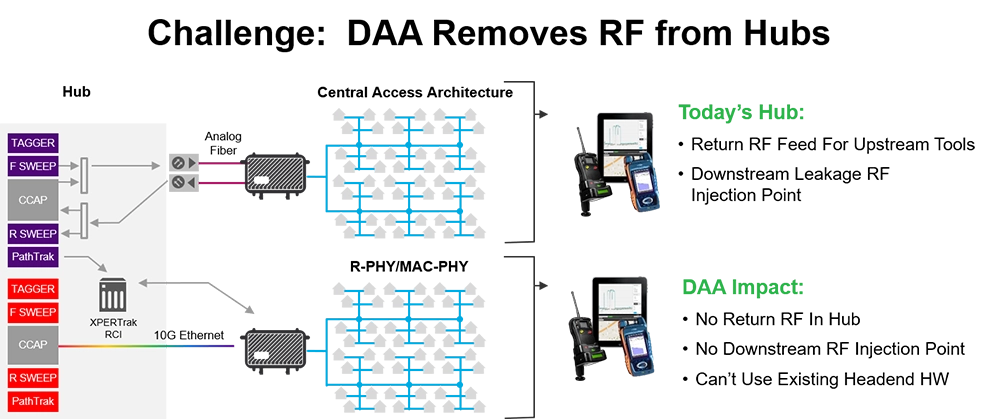
Solution: Virtualized solution with RPD serving as upstream spectrum/sweep receiver, downstream telemetry transmitter. Allows reuse of all existing field gear and operational processes, no changes for technicians whether working on legacy or DAA nodes.
For more information: XPERTrak, OneExpert CATV
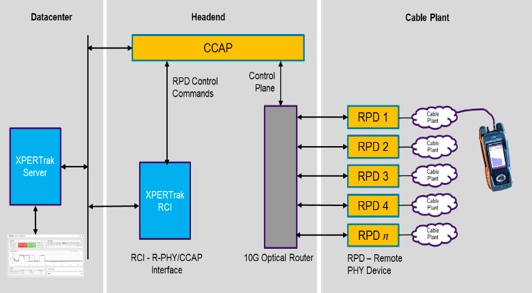
- Solution 1: Virtualize RPD as leakage tag generator to enable reuse of existing field meters
- Solution 2: Deploy signal leakage detectors which can directly detect OFDM carrier leakage and not require signal tagging.
For more information: Seeker X
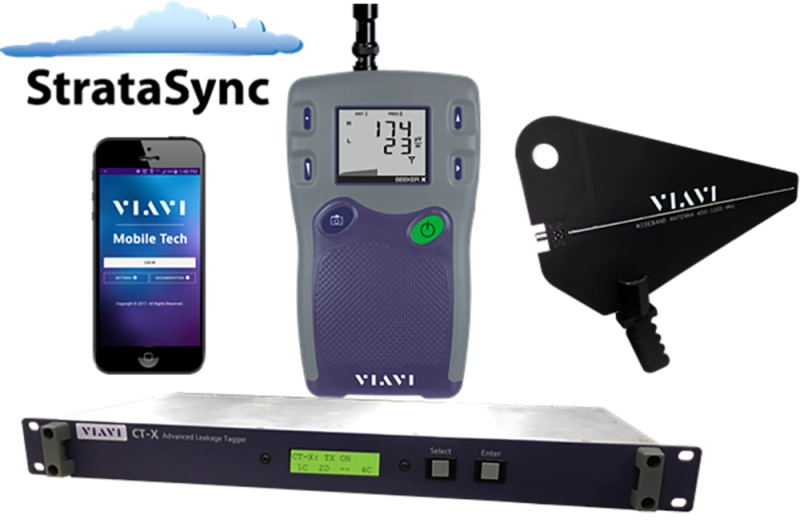
Solution: Sweepless Sweep has steadily gained adoption as an acceptable substitute for active downstream sweep for plants with active services.
For more information: OneExpert CATV
With distributed access architectures RF video is created for the first time at the node, it cannot be verified in the hub as was common with legacy systems. Each service group can have different configs for DOCSIS, SDV, OOB's, and linear video, there are many opportunities for errors to occur through the lifecycle of each and therefore testing of the combined RF signal is critical.
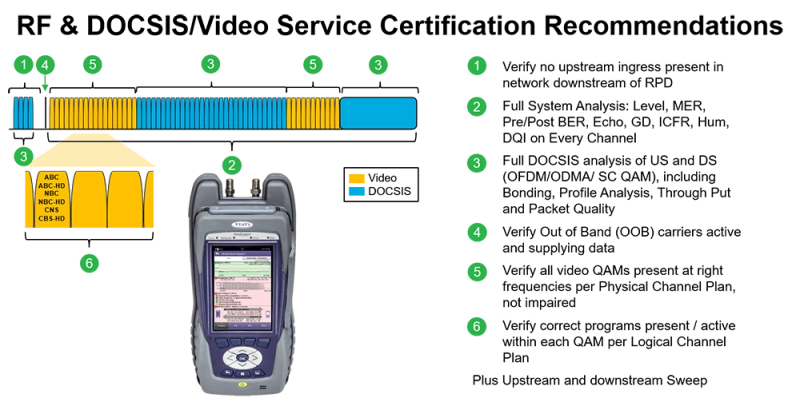
- Solution 1: Rack up all possible set top boxes and video display into a truck. Create a list of all programs that are supposed to be present for each service group. After each RPD is turned up, run a drop from RPD down to truck, connect appropriate set top box(es), manually tune to each program on list and confirm presence and quality. Repeat for each service group for each RPD turned up (~30 minutes per service group)
- Solution 2: OneCheck Expert Video Verification - Automated test using the technicians existing meter that can check all parameters below in <5 minutes per service group.
For more information: OneExpert CATV
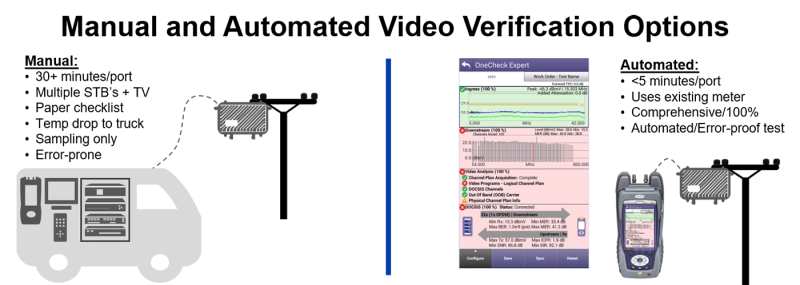
There are MANY more operational challenges presented by DAA deployments, please see DAA Test Guide or R-PHY for full details.
- PTP Timing
- Fiber characterization, new construction and existing fiber
- DWDM test
- Many more…
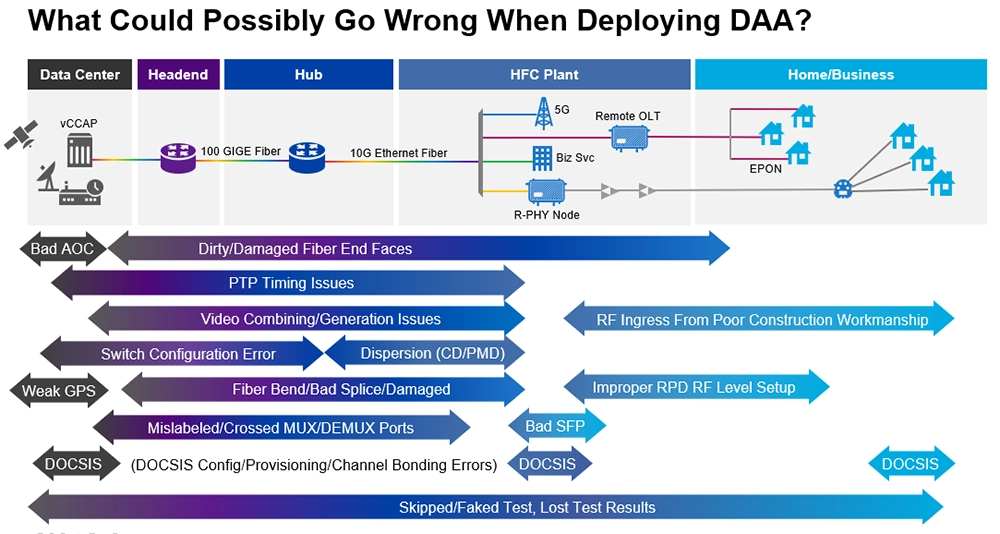
More Hz - Mid-Split and High-Split Extensions
In the past, switching to wider carriers or adding carriers to 42HMz upstreams was an inexpensive and operationally simple way to add incremental upstream bandwidth to a node. Expanding existing 3.2MHz carriers to 6.4 MHz, and then expanding from two to four 6.4 MHz carriers per upstream met demand for many years. Lately operators have been adding 1.6Mhz carriers up against the 42Mhz roll-off region and adding carriers deeper into the junk band below 20Mhz, but these incremental steps are not enough to keep up with upstream demand. Many operators recognize that expanding upstreams to 85Mhz (Mid-Split) or even 204MHz (High Split) are an attractive alternative to defer the need for node splits until DAA matures or FTTH becomes cost-competitive.
Challenges/Solutions
An obvious consequence of expanding upstream spectrum is reducing downstream spectrum available.
- Solution 1: Analog reclamation and improved video compression. In many 860MHz and 1GHz systems these improvements free up enough downstream spectrum to allow mid-split and high-split expansions, but for 750MHz and smaller systems expansions may be required.
- Solution 2: Downstream expansion. For 750 MHz and lower systems considering high split, downstream expansions are often required. While 1GHz extensions have been the standard choice, many operators are looking at deploying 1.2GHz-ready gear to be better prepared for the future. While 1.8GHz support is optional under DOCSIS 3.1, the industry is still a ways out for being fully ready to support this.
Upstream transmitters in amplifiers mush be swapped out to support the new upstream frequency range, and likewise all diplexers in the network must also be swapped out.
- Solution: The solution is obvious, these must all be swapped out. There are several approaches under consideration for how to accomplish this, details are beyond the scope of this web page.
Most return path monitoring gear deployed in the past 10 years is capable of monitoring out to 85MHz, but 204MHz coverage is much less common. Simply expanding spectral range alone is not enough however. DOCSIS 3.1 only specifies support for OFDM-A carriers above 85MHz. Traditional spectral analysis is largely ineffective for wide and seemingly always-on OFDM-A carriers, new techniques are required to detect and troubleshoot ingress in this environment.
A complete 204MHz solution includes both extended spectrum support and Heatmap Spectrum Analysis capabilities to see even bursty ingress under OFDM-A carriers.
- Solution 1: Add 204MHz and Heatmap capable hardware to your return path monitoring system. PathTrak has been the dominant tool for managing upstream ingress for 20+ years, and now there is a 204Mhz version of the HCU200 that is a seamless drop-in for existing systems supporting QAM demodulation up to 85MHz (highest SC-QAM frequency in DOCSIS spec), live spectrum/heatmap analyzers, and spectral monitoring/alarming from 0.5-204MHz.
For more information: HCU204
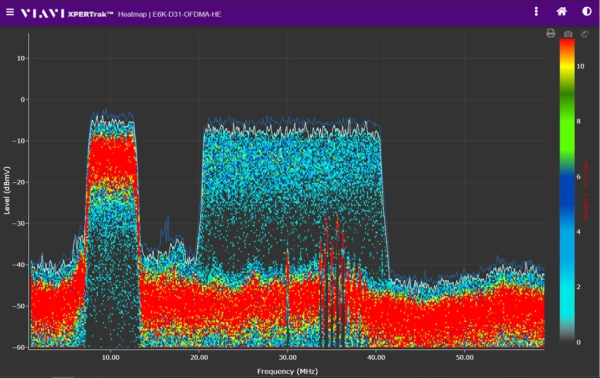

- Solution 2: Use CCAP and/or RPD-based spectrum analysis tools. Although performance of virtualized solutions typically can't match that of dedicated hardware solutions, network architectures like Remote PHY disallow the use of hub-based HW. For these situations, leading HFC maintenance platforms can poll the CCAP or RPD for spectral data to support live analyzers as well as performance monitoring and alarming out to the 85 or 204MHz required for split changes. It is important to be sure virtual option selected support Heatmap spectrum display for visibility under OFDM-A carriers.
For more information: XPERTrak
This is one of the trickiest problems, especially in countries where government mandates exist for monitoring cable plant leakage in aeronautical bands. Even when not mandated, many operators have relied on leakage to keep their plants tight by mitigating ingress opportunities. In high split architectures the aeronautical band is now in the upstream, new solutions must be found to ensure networks are remaining tight against leaks below 258MHz. There are many options under consideration ranging from notching out the upstream for leakage tags, detecting OUDP test bursts, and even using the modems themselves to transmit leakage tag signals.
For more information SCTE Cable Tech Expo 2020 paper, Seeker X, High Split Leakage, High-Split Leakage Video
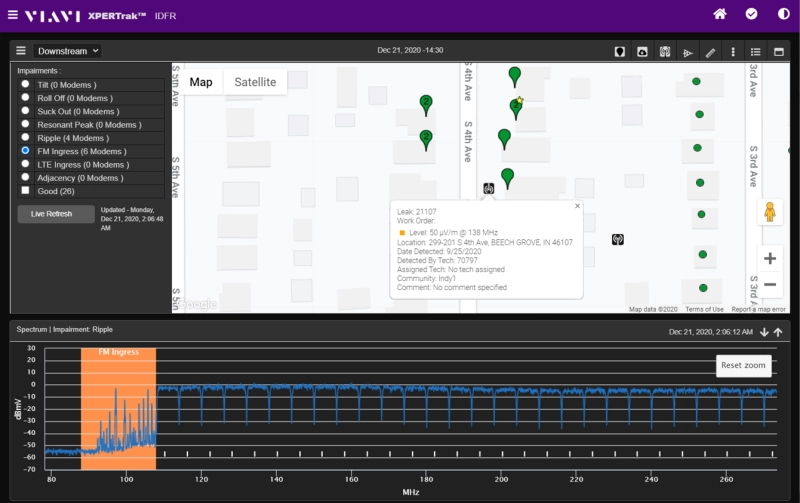
These OOB's are required to support the operation of the millions of legacy (non-DSG) set top boxes deployed today. These currently operate in frequency bands that would be part of the upstream if converting to a high split architecture.
- Solution: See Leakage - same general set of options applies plus possibly upconverting and retransmitting at higher frequencies.
FM interference is a significant problem in the downstream today because FM signals are everywhere, any network shielding weakness will result in ingress into the plant. Today it is a downstream problem and can be localized via Full-Band Capture CPE and indirectly via signal leakage technologies. With high-split architectures it becomes an upstream problem, increasing impact and forcing change in how we detect and fix it.
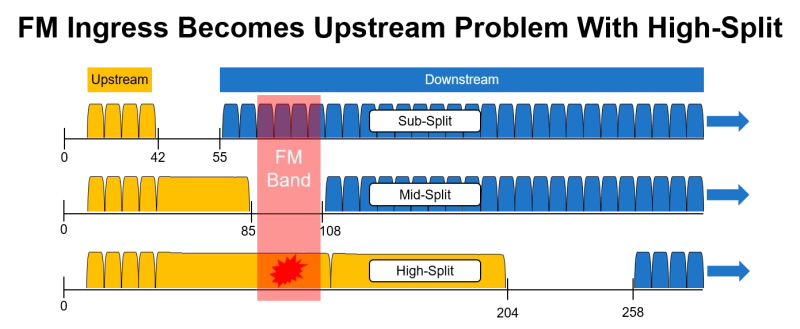
Solutions (Pre-High Split Transition):
- Tighten up your plant - basic ingress remediation including pressure testing homes and drops.
For more information: HL Leakage - Use Full-Band Capture CPE to detect and localize FM ingress sources present today.
For more information: XPERTrak - Use signal leakage tools to detect, find, and fix leaks at frequencies as close to the FM band as possible - ideally overlay detected leaks and Full-Band Capture FM Ingress fails on same map.
For more information: Seeker X
Solutions (Post Transition):
- Use heat map displays on return path monitoring systems and field meters to detect FM leakage present under OFDMA carriers.
For more information: XPERTrak, OneExpert CATV - Leverage frequency-agile signal leakage systems to detect leaks at the lowest point on the downstream spectrum possible.
For more information: Seeker X
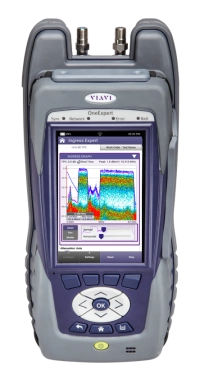

Sweep gear must be capable of supporting return sweep to 85 or 204MHz, and possibly out to 1.2GHz in the downstream for cases where extension is required to maintain adequate downstream capacity upon upstream split changes.
- Solution 1: Deploy sweep gear capable of supporting the new frequency bands. VIAVI offers the SCU-1800 supporting return sweep up to 204MHz and downstream sweep to 1.218GHz, plus OneExpert Sweep Meters with diplex combinations to meet all common combinations of plant architectures.
For more information: Product 1: SCU-1800 Sweep Control Unit, OneExpert CATV - Solution 2: Return Sweepless Sweep - This method does not inject any sweep pulses and instead uses existing DOCSIS carriers. It produces a higher resolution response diagram and self-adapts to any changes in upstream configuration including split changes. The primary challenge with this option for split changes is that unoccupied spectrum is not characterized. There is no visibility into the extended spectrum until carriers are turned up. The other downsides are that it is not as responsive as traditional or Rapid Sweep and requires DOCSIS services be up negating its use during construction and service outages.
For more information: OneExpert CATV
More Bits/Hz - Deploying OFDMA
OFDM has been successfully deployed in the downstream for many years now to squeeze additional bandwidth out of every Hz of downstream spectrum, but OFDMA deployments have lagged due to technology immaturity and lack of market drivers. Both of these barriers are rapidly disappearing as NEMS deploy stable OFDMA solutions and spiking upstream demand has forced operators to quickly get more upstream capacity out of their networks. OFDMA is an especially attractive option for operators with significant DOCSIS 3.1 CPE deployments as it does not require touching the outside plant at all to deploy. Operators can quickly unlock more capacity with only a FW upgrade for existing CPE/CCAP's and related back office process adjustments.
Challenges/Solutions
As upstreams fill up with wide and seemingly always-on OFDM-A carriers traditional spectrum analyzer displays lose effectiveness. Min hold will still catch persistent ingressors, but good luck with anything bursty in nature.
- Solution: Spectral heatmap analysis on return path monitoring systems and field instruments. Perfect for seeing all types of ingress underneath OFDMA and SC-QAM carriers. For more information: XPERTrak, OneExpert CATV


Traditional return sweep would consist of discrete sweep points places in the guard band between upstream carriers, but wide OFDMA carriers create blind spots using this approach.
- Traditional sweep through OFDMA carriers - This method is still the fastest/most responsive for amplifier balance and alignment and works even when services are down making it a critical tool for troubleshooting outages. There is a potential to create a minor service impact under certain DOCSIS modulation profile configurations, these can be minimized through careful setup. Fore more information: SCU-1800 Sweep Control Unit, OneExpert CATV
- Rapid Sweep - This evolution of traditional sweep was developed specifically to further minimize chances of service impact for OFDMA carriers and uses existing headend gear and field meters. Fore more information: SCU-1800 Sweep Control Unit, OneExpert CATV
- Return Sweepless Sweep - This method does not inject any sweep pulses and instead uses existing DOCSIS carriers. It produces a higher resolution response diagram and self-adapts to any changes in upstream configuration. The only downsides are that it is not as responsive as traditional or Rapid Sweep, only covers occupied spectrum, and requires DOCSIS services be up negating its use during construction and service outages. For more information: OneExpert CATV
Testing 1GB/sec+ Upstream Services - When customers pay for premium service tiers they want to know that they are receiving them. Even some of the newer field meters in use today are not capable of testing to these speeds.
- Solution: Deploy field meters capable of testing at highest speed tier offered or preferably higher to accommodate future offerings. This includes DOCSIS throughput as measured by the field meter plus throughput available via CPE Ethernet and Wifi connections. For more information: OneExpert CATV
OFDMA introduces a whole new set of metrics to monitor, and while on the surface they can be confusing they can also be quite powerful if analyzed and presented in an understandable way. For more information: XPERTrak
- Solution: Include OFDMA metrics including PNM capabilities into existing monitoring and troubleshooting systems. Leverage the new capabilities to accurately rank nodes based on subscriber churn risk, and integrate everything into existing displays and indices to ease the transition for technicians. Break out the advanced OFDMA capabilities into separate displays for power users and boil the results down to just what is meaningful to them. For more information: XPERTrak
